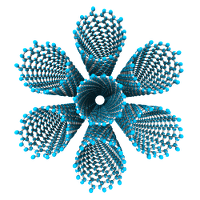Command line script (sknano.scripts.nanogen)¶
CLI to sknano.generators tools.
This module allows for easy structure generation from the command line.
See also
> nanogen --help
usage: nanogen [-h] [--basis ELEMENT1 ELEMENT2] [--bond BOND] [--fname FNAME]
[--structure-format {data,xyz}] [--verbose] [--debug]
[--version]
{graphene,bilayer_graphene,swnt,unrolled_swnt,mwnt,swnt_bundle,mwnt_bundle}
...
optional arguments:
-h, --help show this help message and exit
--basis ELEMENT1 ELEMENT2
2 element symbols or atomic numbers of the two atom
basis (default: ['C', 'C'])
--bond BOND Bond length between nearest-neighbor atoms. Must be in
units of Angstroms. (default: 1.42)
--fname FNAME structure file name
--structure-format {data,xyz}
structure file format (default: xyz)
--verbose verbose output
--debug debug output
--version show nanogen's version number and exit
sub-commands:
{graphene,bilayer_graphene,swnt,unrolled_swnt,mwnt,swnt_bundle,mwnt_bundle}
-
sknano.scripts.nanogen.nanogen(generator_class=None, fname=None, structure_format='xyz', **kwargs)[source][source]¶ Generate nano-structure data.
Parameters: generator_class : str
nano-structure generator class
fname : str, optional
structure file name
structure_format : str, optional
output file format
Examples¶
The following command generates a graphene sheet with a 10 nm long armchair edge and 1 nm long zigzag edge and saves the data in the LAMMPS data format.:
> nanogen --structure-format data graphene 10 1
This command will generate a \((20, 0)\) SWNT, 5 unit cells long and saves the data in xyz format.:
> nanogen swnt --Ch 20 0 --nz 5
Notes¶
The nanogen script calls the nanogen
function and neither the script nor the function allow for generating
multiple structures per call. It’s easy to do this using the scripting
capabilities of the shell or from within an interactive Python session.
For example, if you have a list of chiralities that you want structure data for, you can do something like this from within an interactive session:
>>> from sknano.structures import generate_Ch_list
>>> from sknano.generators import SWNTGenerator
>>> # Generate your list of (n, m) chiralities
>>> Ch_list = generate_Ch_list(ni=5, nf=25, mi=0, mf=25, handedness='right')
>>> for Ch in Ch_list:
... SWNTGenerator(Ch).save(structure_format='data')
